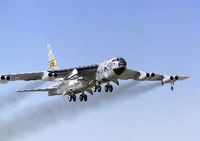B-52 STRATOFORTRESS - Mission: Air Combat Command's B-52 is a long-range, heavy bomber that can perform a variety of missions. The bomber is capable of flying at high subsonic speeds at altitudes up to 50,000 feet (15,166.6 meters). It can carry nuclear or precision guided conventional ordnance with worldwide precision navigation capability.
Features: In a conventional conflict, the B-52 can perform strategic attack, air interdiction, offensive counter-air and maritime operations. During Desert Storm, B-52s delivered 40 percent of all the weapons dropped by coalition forces. It is highly effective when used for ocean surveillance, and can assist the U.S. Navy in anti-ship and mine-laying operations. Two B-52s, in two hours, can monitor 140,000 square miles (364,000 square kilometers) of ocean surface.
All B-52s are equipped with an electro-optical viewing system that uses platinum silicide forward-looking infrared and high resolution low-light-level television sensors to augment targeting, battle assessment, and flight safety, thus further improving its combat ability and low-level flight capability.
Pilots wear night vision goggles (NVG) to enhance their vision during night operations. Night vision goggles provide greater safety during night operations by increasing the pilot's ability to visually clear terrain, avoid enemy radar and see other aircraft in a covert/lights-out environment.
 | B-52 'Mothership' retires, OVER EDWARDS AIR FORCE BASE, Calif. -- NASA's B-52B launch aircraft takes off carrying an X-43A hypersonic research aircraft on an evaluation flight Sept. 27. |
Photo, Text Disclaimer:
1. Air Force Link is provided as a public service by the Office of the Secretary of Air Force (Public Affairs).
2. Information presented on Air Force Link is considered public information and may be distributed or copied. Use of appropriate byline/photo/image credits is requested.
Generally speaking, works created by U.S. Government employees are not eligible for copyright protection in the United States. See Circular 1 "COPYRIGHT BASICS" from the U.S. Copyright Office.
Starting in 1989, on-going modifications incorporates the global positioning system, heavy stores adapter beams for carrying 2,000 pound munitions, and a full array of advance weapons currently under development.
The use of aerial refueling gives the B-52 a range limited only by crew endurance. It has an unrefueled combat range in excess of 8,800 miles (14,080 kilometers).
The aircraft's flexibility was evident in Operation Desert Storm and again during Operations Allied Force. B-52s struck wide-area troop concentrations, fixed installations and bunkers, and decimated the morale of Iraq's Republican Guard. The Gulf War involved the longest strike mission in the history of aerial warfare when B-52s took off from Barksdale Air Force Base, La., launched conventional air launched cruise missiles and returned to Barksdale -- a 35-hour, non-stop combat mission.
During Operation Allied Force, B-52s opened the conflict with conventional cruise missile attacks and then transitioned to delivering general purpose bombs and cluster bomb units on Serbian army positions and staging areas.
Related: Public Domain Clip Art Archive June - July 2005 and
Aircraft
Technorati tags: Public Domain Clip Art and clip art or public domain and aircraft or planes and B-52 Stratofortress or Nanotechnology Today or Public Domain Clip Art and Republican National Convention Blog














No comments:
Post a Comment